Catching neutrinos deep in the ice!
Temperature: minus 25.1.5 C, minus 12.7 F Windchill: minus 31.2 C, minus 28.7 Wind: 5 knots Weather: bright and sunny with some clouds, changing to cloudy
I went to the gym in the morning and had my first shower here at the station. Yes, we have a gym! Please check on future journals for "Life at the South Pole Station”. I will cover many aspects of life and work at this new South Pole station.
While I was writing in the "Quiet reading room” 4 skiers from 4 different countries came in during a tour of the station. They just arrived earlier in the morning after 8 days the Antarctic plateau and they were awaiting their ride back with a "Twin Otter” plane. It was great hearing about heir adventure and the skier from Germany was happy to converse in his own language. They pitched up their tents away from the station and the Geographic Pole and will leave tomorrow.
**Skiers arrived at the Pole
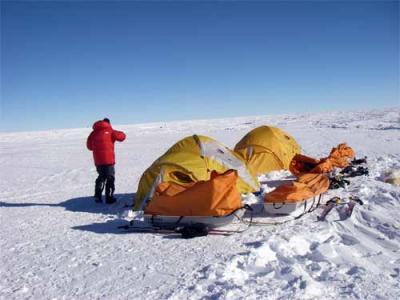 *The Ski team arrived form Patriot Hill at South Pole Station. They skied for 8 days from 89 Degrees South.
*The Ski team arrived form Patriot Hill at South Pole Station. They skied for 8 days from 89 Degrees South.
After more writing, I went to the open house of the "Ice Cube Project”, one of the most elaborate science projects here at the station. 150 people out of 258 at the station work for that project! I was late, so I put on my gear quickly and walked to the crossing of the ski-way to the road that leads to the "Dark Sector”. Even further away than the telescope is the camp of the "Ice Cube Project”. I "hitched” a ride with a snow mobile passing by and was lucky still to get a tour.
**Crossing the Ski-way (runway).
**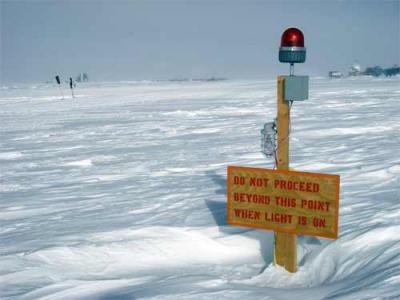 When crossing the ski way one has to be aware of this light being on. That would signal that a plane is arriving or leaving. Left of the sign on the horizon is the "Ice Cube " project camp; to the right is the telescope "Dark Sector”.*
When crossing the ski way one has to be aware of this light being on. That would signal that a plane is arriving or leaving. Left of the sign on the horizon is the "Ice Cube " project camp; to the right is the telescope "Dark Sector”.*
The "Ice Cube Project” project is about detecting neutrinos and learning more about the expansion of the universe! These neutrinos are the ones from the northern hemisphere that have been filtered through the earth. In order to detect them DOM’s ( Digital Optical Module ) are put into a hole 2500m deep into the ice sheet. Since we have 2900meters of accumulated ice, the Antarctic plateau is a perfect place for this project.
**The neutrino detector: DOM **
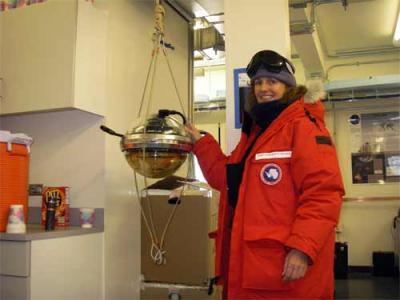 17 of these DOM’s (Digital optical Module) are put on string and lowered into the ice hole.*
17 of these DOM’s (Digital optical Module) are put on string and lowered into the ice hole.*
25 of these holes do already exist. 18 more are planned to be "drilled” into the ice this season. 3 are already completed. Each string with its 17 DOM’s is a certain distance apart from the next string of DOMs. All the string of domes take up a space of 1km square inside the ice within the 2500m ice holes, that is the reason why this project is called ”Ice Cube”. Imagine a 1km square ice cube deep into the ice of the Antarctic plateau detecting neutrinos and its energy! However, as I was told (and I hope I understood correctly) this can only be done indirectly if the neutrino hits an ice crystal and the ice crystal hits another particle, called a muon, The muon emits a certain radiation that can be measured. This emission of energy will give scientists an idea about the expansion of the universe, among many other things! Amazing.
**The DOM ice hole **
 This is the top of the 2500m that will contain the 17 DOM’s or neutrino detectors.*
This is the top of the 2500m that will contain the 17 DOM’s or neutrino detectors.*
The hole has to be "drilled” into the ice with hot water. A lot of resources are needed to melt ice to get water, to heat the water and keep it at about 87 degree Celsius, just below the boiling point at this altitude, and to assure a certain amount of water pressure. A lot of resources are needed to provide the "drilling water”
**"Ice Cube" camp.
**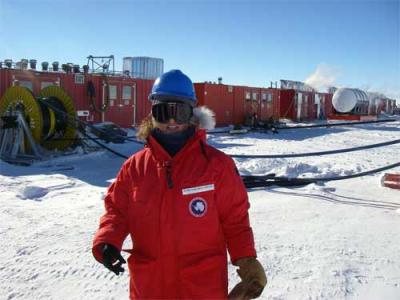 Elke is standing in front of some of the many buildings containing generator, heaters, and water containers.*
Elke is standing in front of some of the many buildings containing generator, heaters, and water containers.*
**"Ice Cube - water well”
**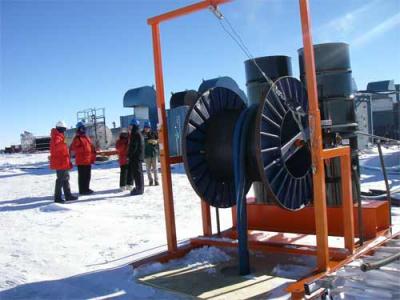 The front structure is the "water well”. The ice is heated to produce water for the "drill”.*
The front structure is the "water well”. The ice is heated to produce water for the "drill”.*
**A hose to "drill” the ice
**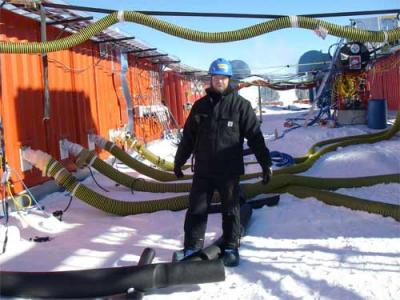 This 4 inch tube next to the engineer will contain the "water drill”. The actual nosel opening is 3/4th of an inch wide.*
This 4 inch tube next to the engineer will contain the "water drill”. The actual nosel opening is 3/4th of an inch wide.*
All strings of all of the ice holes combined end up in this silver tank outside the computer building. Inside the building, rooms full of computers combine all the information for each DOM and each string to detect neutrino movement.
**A building for the DOM strings
**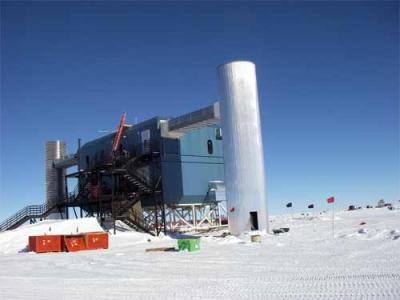 This is the building with the silver tank.*
This is the building with the silver tank.*
This is Paul, the computer engineer, who is working in the computer room.
**Electronic heaven
**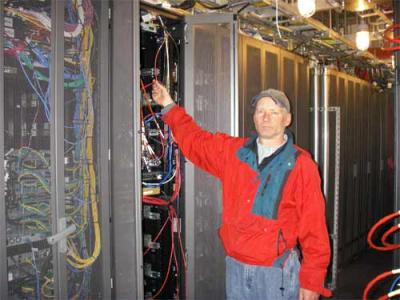 Paul, the computer engineer is pointing out how each DOM string is connected to a computer.*
Paul, the computer engineer is pointing out how each DOM string is connected to a computer.*
Here is the website for the "Ice Cube Project’. I hope all your physics teacher out there will be able to use some of this information.
Later in the day I visited the skier team to learn more about their adventure. My day ended after midnight when I stopped writing. I started my Monday at 5:30 am to send more pictures and webinar information during the best satellite times.

